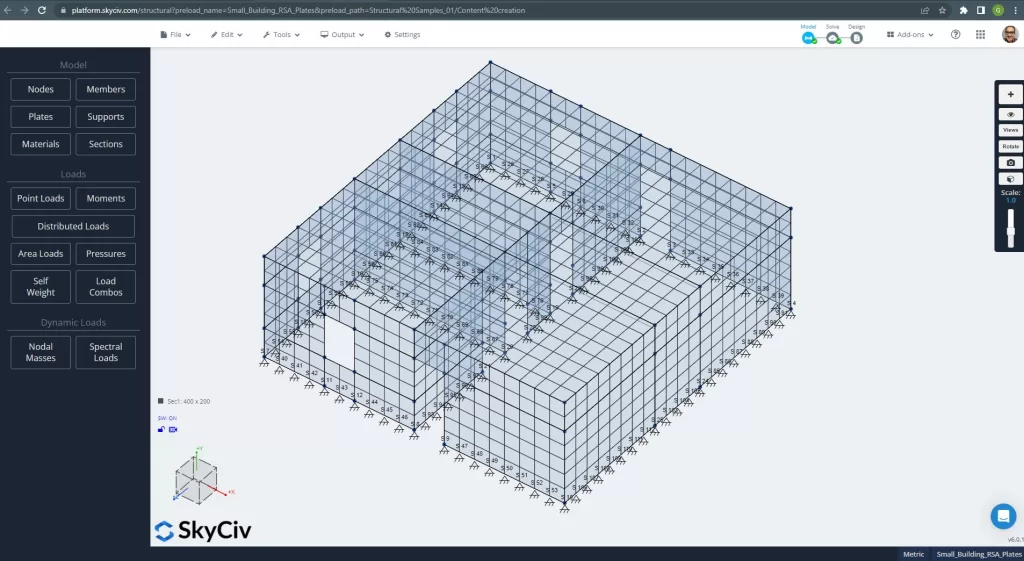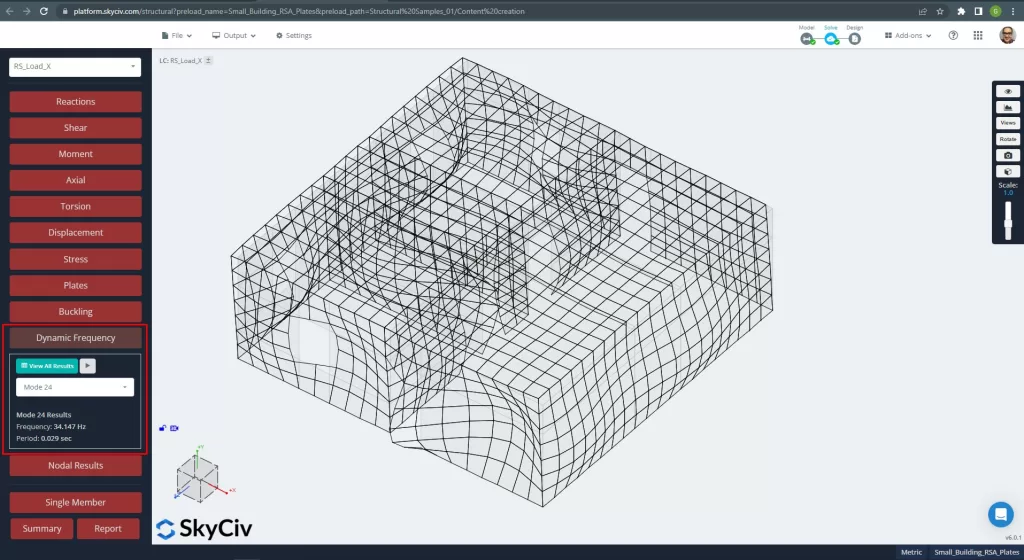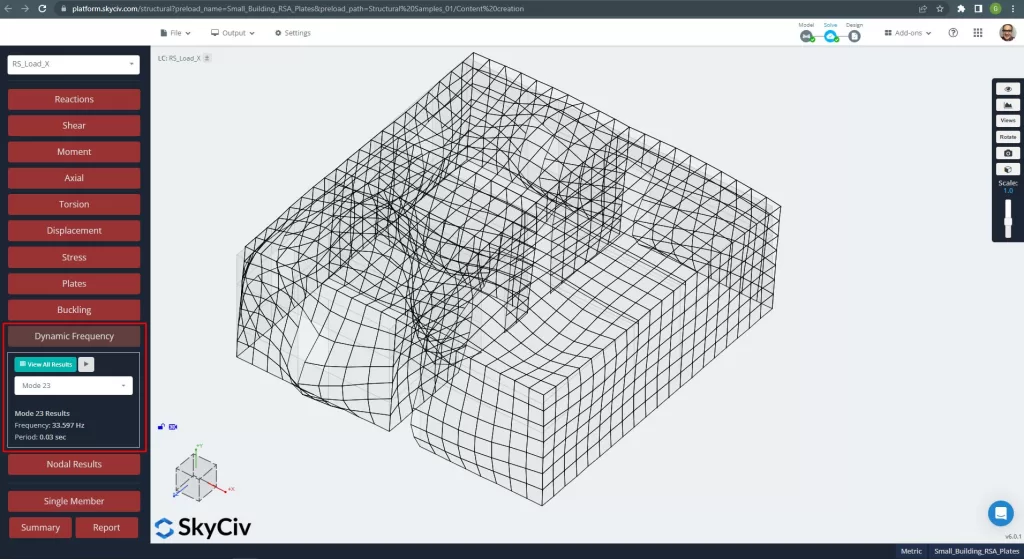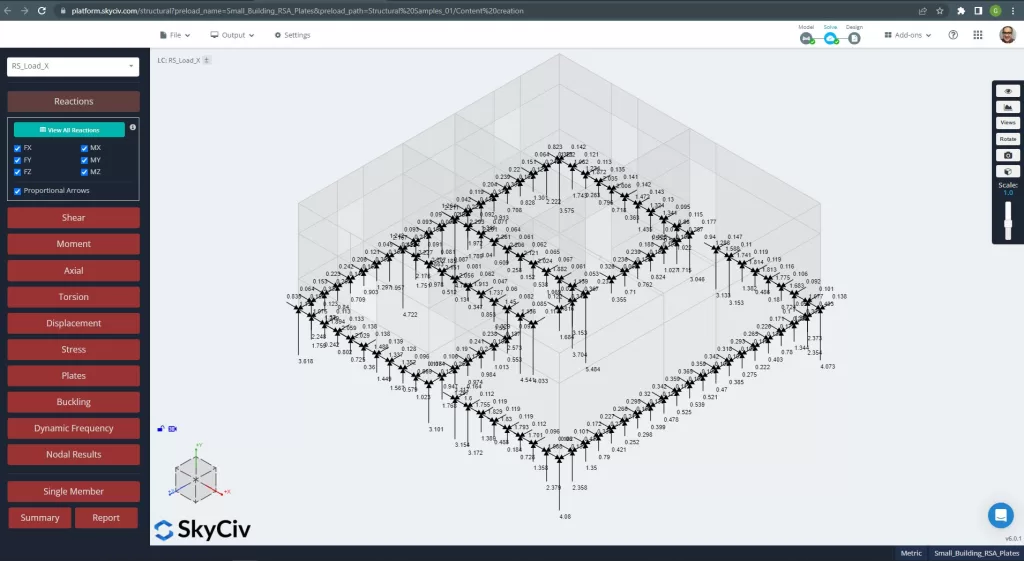Descripción general
SkyCiv ha incluido una nueva y potente función que consiste en el análisis del espectro de respuesta de las placas en la plataforma.. En este artículo, Cubriremos un ejemplo de un edificio pequeño., como muestra la siguiente imagen. El objetivo principal es explicar algunos detalles esenciales al realizar un análisis similar por su cuenta..

Figura 1. Ejemplo de edificio pequeño
Se puede ver que la pequeña estructura de hormigón armado tiene paredes y losas construidas utilizando el elemento de placa SkyCiv.. Al diseñar el edificio para cargas dinámicas como terremotos., la mayoría de los códigos de construcción establecen algunos métodos como el 'Procedimiento o Análisis del Espectro de Respuesta' (RSA).’
El RSA consiste en tomar la aceleración del nivel de diseño sísmico a través de una curva suave dada por el código. Puedes leer estos artículos de SkyCiv: Análisis del espectro de respuesta: Un ejemplo de construcción y un análisis del espectro de respuesta: Métodos de combinación modal para obtener más información y ejemplos Análisis del espectro de respuesta: Ejemplos de construcción y Análisis del espectro de respuesta: Métodos de combinación modal.
Si eres nuevo en SkyCiv, Regístrese y pruebe el software usted mismo!
Modelo de elementos finitos: Análisis dinámico de placas
Una vez definida la geometría y los materiales para el ejemplo., El siguiente paso crucial es ejecutar un análisis lineal de una estructura mallada.. Por favor mire el modelo en la Figura. 2.

Figura 2. Edificio pequeño mallado
La ecuación de movimiento a resolver al ejecutar un análisis de espectro de respuesta tiene la forma de:
\({A mí}{\punto{X_e}}+{c_e}{\punto{X_e}}+{k_e}{X_e}={-\punto{X_0}{(t)}{A mí}{J}}\)
Dónde:
- \({A mí}\) es la matriz consistente para masas.
- \({c_e}\) es la matriz de amortiguación (A menudo, este valor podría calcularse como la combinación lineal de matrices de rigidez y masas \({c_e}={\alfa}{k_e}+{\beta}{M}\) ).
- \({k_e}\) es la matriz de rigidez.
- \({X_e}\) es el vector de desplazamiento relativo a la base de la estructura.
- \({X_0}{(t)}\) es el vector de desplazamiento del suelo (Tiene todos los grados de libertad.: 3 desplazamientos y tres rotaciones).
- \({J}\) es un vector con componentes unitarios.
Due SkyCiv utilizando el método de elementos finitos para placas, la matriz \({A mí}\) podría obtenerse mediante la siguiente expresión para la energía cinética:
\({CE}={\frac{1}{2}}{\En t_{volumen} {\rho}{\punto{x}^ 2}{dw}Vol.}\) .
ahora escribimos el \(X) desplazamiento en función de sus nodos y utilizar algunas expresiones de interpolación (\(NORTE_{x}^{T}\)).
\({x}=N_{x}^{T} {x}\). Si reemplazamos este valor en la ecuación de energía, obtenemos:
\({CE}={\frac{1}{2}}{\punto{x}^{T}}\{{\En t_{volumen}{\rho}{norte}{N^T}{d}{Vol.}}\} \punto{x} \)
Entonces, podemos decir eso:
\( Determine la deflexión y el ángulo de rotación en el extremo B de la viga mostrada en la figura {\En t_{volumen}{\rho}{norte}{N^T}{d}{Vol.}}\)
Definir la matriz anterior nos permite ejecutar un análisis modal, que se requiere para el análisis dinámico. Figura 3 nos ayuda con algunos aportes recomendados.

Figura 3. Modos máximos considerados aumentados hasta 40
Se recomienda aumentar el número total de modos hasta cumplir estrictamente los códigos.. Esto afectará los factores de participación masiva total., que deben alcanzar un valor de 90%.
Cargas espectrales
El siguiente paso es definir las cargas espectrales.. Podemos incluir una función personalizada o tomar los casos previamente construidos por la plataforma SkyCiv.. Este ejemplo utiliza para cada dirección principal del plano de construcción una parcela ASCE.. Verifique las entradas en la Figura 4 y figura 5.

Figura 4. Configuración para RSA, parte uno

Figura 5. Configuración para RSA, la segunda parte
Si eres nuevo en SkyCiv, Regístrese y pruebe el software usted mismo!
Análisis de resultados y conclusiones.

Figura 6. Resumen de modalidades y participación masiva, parte uno

Figura 7. Resumen de modalidades y participación masiva, parte uno
Cifras 6 y 7 Dar los modos y valores de participación masiva.. Estas tablas definen los principales modos en cada dirección del plan correspondientes a aquellos con mayores valores de participación masiva..
Modo 24, T = 0.029 segundos, participación masiva = 44.80 % 'dirección x':

Figura 8. Modo modal principal para la dirección X.
Modo 23, T = 0.030 segundos, participación masiva = 41.80 % 'dirección z':

Figura 9. Modo modal principal para la dirección Z.
SkyCiv también da los desplazamientos., efectivo, tensiones, y así sucesivamente al ejecutar el RSA. Las siguientes imágenes nos ayudan a entender cómo se comportan los edificios..

Figura 10. Desplazamientos en dirección X para el caso de carga RSA.

Figura 11. Desplazamiento en la dirección Z para el caso de carga RSA.
Ahora puedes diseñar los elementos de la placa con esos resultados.. Te sugerimos leer los artículos de SkyCiv sobre Diseño de Placas: Módulo de diseño de placas y ejemplos de losas basadas en código aplicado en los siguientes enlaces: ACI, AS-3600 y Eurocódigo 2.
también, con SkyCiv, Podemos obtener las reacciones base para el diseño de los cimientos..

Figura 12. Reacciones base para el caso de carga RSA.
Sólo tenga en cuenta las señales de resultados.! Todos ellos vinieron en valores positivos o absolutos.. Esto se debe a que obtenemos los valores absolutos máximos para cada componente de diseño cuando utilizamos un método RSA..
Si eres nuevo en SkyCiv, Regístrese y pruebe el software usted mismo!


